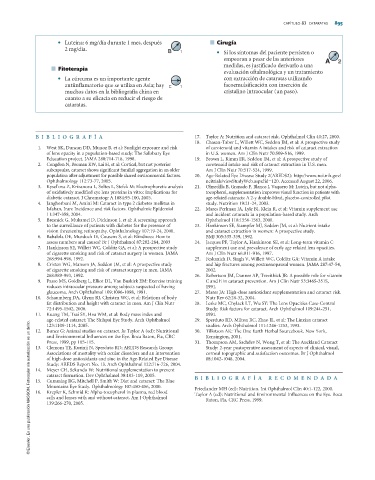Page 874 - medicina-integrativa_compress
P. 874
CAPÍTULO 83 CATARATAS 895
• Luteína: 6 mg/día durante 1 mes, después ■ Cirugía
2 mg/día.
B B 1 • Si los síntomas del paciente persisten o
empeoran a pesar de las anteriores A A 2 2
medidas, es justificado derivarlo a una
■ Fitoterapia
evaluación oftalmológica y un tratamiento
• La cúrcuma es un importante agente con extracción de cataratas utilizando
antiinflamatorio que se utiliza en Asia; hay C 1 facoemulsificación con inserción de
muchos datos en la bibliografía china en cristalino intraocular (un paso).
cuanto a su eficacia en reducir el riesgo de
cataratas.
BIBLIOGRAFÍA 17. Taylor A: Nutrition and cataract risk. Ophthalmol Clin 40:27, 2000.
18. Chasan-Taber L, Willett WC, Seddon JM, et al: A prospective study
1. West SK, Duncan DD, Munoz B, et al: Sunlight exposure and risk of carotenoid and vitamin A intakes and risk of cataract extraction
of lens opacity in a population-based study: The Salisbury Eye in U.S. women. Am J Clin Nutr 70:509-516, 1999.
Education project. JAMA 280:714-718, 1998. 19. Brown L, Rimm ER, Seddon JM, et al: A prospective study of
2. Congdon N, Broman KW, Lai H, et al: Cortical, but not posterior carotenoid intake and risk of cataract extraction in U.S. men.
subcapsular, cataract shows significant familial aggregation in an older Am J Clin Nutr 70:517-524, 1999.
population after adjustment for possible shared environmental factors. 20. Age-Related Eye Disease Study 2(AREDS2): http://www.nei.nih.gov/
Ophthalmology 112:73-77, 2005. neitrials/viewStudyWeb.aspx?id=120. Accessed August 22, 2006.
3. Kysel’ova Z, Krizanova L, Soltes L, Stefek M: Electrophoretic analysis 21. Olmedilla B, Granado F, Blanco I, Vaquero M: Lutein, but not alpha-
of oxidatively modified eye lens proteins in vitro: Implications for tocopherol, supplementation improves visual function in patients with
diabetic cataract. J Chromatogr A 1084:95-100, 2005. age-related cataracts: A 2-y double-blind, placebo-controlled pilot
4. Janghorbani M, Amini M: Cataract in type 2 diabetes mellitus in study. Nutrition 19:21-24, 2003.
Isfahan, Iran: Incidence and risk factors. Ophthalmic Epidemiol 22. Mares Perlman JA, Lyle BJ, Klein R, et al: Vitamin supplement use
11:347-358, 2004. and incident cataracts in a population-based study. Arch
5. Bresnick G, Mukamel D, Dickinson J, et al: A screening approach Ophthalmol 118:1556-1563, 2000.
to the surveillance of patients with diabetes for the presence of 23. Hankinson SE, Stampfer MJ, Sedden JM, et al: Nutrient intake
vision threatening retinopathy. Ophthalmology 107:19-24, 2000. and cataract extraction in women: A prospective study.
6. Babalola OE, Murdoch IE, Cousens S, et al: Blindness: How to BMJ 305:335-339, 1992.
assess numbers and causes? Br J Ophthalmol 87:282-284, 2003 24. Jacques PF, Taylor A, Hankinson SE, et al: Long-term vitamin C
7. Hankinson SE, Willett WC, Colditz GA, et al: A prospective study supplement use and prevalence of early age related lens opacities.
of cigarette smoking and risk of cataract surgery in women. JAMA Am J Clin Nutr 66:911-916, 1997.
268:994-998, 1992. 25. Feskanich D, Singh V, Willett WC, Colditz GA: Vitamin A intake
8. Cristen WG, Manson JA, Seddon JM, et al: A prospective study and hip fractures among postmenopausal women. JAMA 287:47-54,
of cigarette smoking and risk of cataract surgery in men. JAMA 2002.
268:989-993, 1992. 26. Robertson JM, Danner AP, Trevithick JR: A possible role for vitamin
9. Passo MS, Goldberg L, Elliot DL, Van Buskirk EM: Exercise training C and E in cataract prevention. Am J Clin Nutr 53:346S-351S,
reduces intraocular pressure among subjects suspected of having 1991.
glaucoma. Arch Ophthalmol 109:1096-1098, 1991. 27. Mares JA: High-dose antioxidant supplementation and cataract risk.
10. Schaumberg DA, Glynn RJ, Christen WG, et al: Relations of body Nutr Rev 62:28-32, 2004.
fat distribution and height with cataract in men. Am J Clin Nutr 28. Leske MC, Chylack LT, Wu SY: The Lens Opacities Case-Control
72:1495-1502, 2000. Study: Risk factors for cataract. Arch Ophthalmol 109:244-251,
11. Kuang TM, Tsai SY, Hsu WM, et al: Body mass index and 1991.
age-related cataract: The Shihpai Eye Study. Arch Ophthalmol 29. Sperduto RD, Milton RC, Zhao JL, et al: The Linxian cataract
© Elsevier. Es una publicación MASSON. Fotocopiar sin autorización es un delito.
123:1109-1114, 2005. studies. Arch Ophthalmol 111:1246-1253, 1993.
12. Bunce G: Animal studies on cataract. In Taylor A (ed): Nutritional 30. Tillotson AK: The One Earth Herbal Sourcebook. New York,
and Environmental Influences on the Eye. Boca Raton, Fla, CRC Kensington, 2001.
Press, 1999, pp 105-115. 31. Thompson AM, Sachdev N, Wong T, et al: The Auckland Cataract
13. Clemons TE, Kurinij N, Sperduto RD; AREDS Research Group: Study: 2-year postoperative assessment of aspects of clinical, visual,
Associations of mortality with ocular disorders and an intervention corneal topographic and satisfaction outcomes. Br J Ophthalmol
of high-dose antioxidants and zinc in the Age-Related Eye Disease 88:1042-1048, 2004.
Study: AREDS Report No. 13. Arch Ophthalmol 122:716-726, 2004.
14. Meyer CH, Sekundo W: Nutritional supplementation to prevent
cataract formation. Dev Ophthalmol 38:103-119, 2005. BIBLIOGRAFÍA RECOMENDADA
15. Cumming RG, Mitchell P, Smith W: Diet and cataract: The Blue
Mountains Eye Study. Ophthalmology 107:450-456, 2000. Friedlander MH (ed): Nutrition. Int Ophthalmol Clin 40:1-122, 2000.
16. Krepler K, Schmid R: Alpha-tocopherol in plasma, red blood Taylor A (ed): Nutritional and Environmental Influences on the Eye. Boca
cells and lenses with and without cataract. Am J Ophthalmol Raton, Fla, CRC Press, 1999.
139:266-270, 2005.

